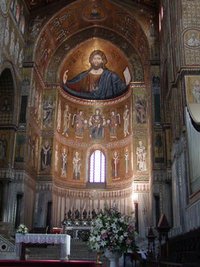Mosaic
|
|
Missing image Amphitrite_mosaic.jpg Detail of mosaic from Herculaneum depicting Amphitrite |
Missing image Mosaic.woodchester.arp.750pix.jpg A small part of The Great Pavement, a Roman mosaic laid in AD 325 at Woodchester, Gloucestershire, England. |
Missing image Michael_of_salonica.jpg Early 12th-century Kievan mosaic depicting St. Demetrius. |
Mosaic is a medium of art that may embody the most meaningful iconography in a culture's most important settings, as in the cathedral of Monreale (below), or it may be a technique of decorative art, an aspect of interior decoration. In mosaics, small tiles or fragments of pottery (known as tesserae, diminutive tessellae) or of colored glass or clear glass backed with metal foils, are used to create a pattern or picture.
| Contents |
Uses of mosaic
Mosaic was used across the ancient world for domestic interior decoration. Mosaics of the 4th century BC are found in the Macedonian palace-city of Aegina and they enriched the floors of Hellenistic villas, but mosaic floors are particularly associated with Roman dwellings, from Britain (illustration, right) to Dura-Europas. Splendid mosaic floors distinguished luxurious Roman villas across north Africa. In Rome, Nero and his architects innovated the extension of refined mosaics to cover the surfaces of wall and ceilings in the Domus Aurea, built 64 CE.
When Christian basilicas began to be purpose-built in the late 4th century, wall and ceiling mosaics were adapted to Christian uses. The greatest development of Christian mosaics unfolded in the Byzantine empire including its outpost the Exarchate of Ravenna and its territories in Sicily, and in its late rival Venice, where mosaic encrusts the exterior and interior of St Mark's. In Western Europe, the demanding techniques of fresco replaced the even more labor-intensive techniques of mosaic.
Islamic architecture was the next inheritor of this technique. The intricate geometric designs used to decorate buildings in the Islamic world are often produced as mosaics. The process is known as zillij in North Africa and qashani further east. Some of the best examples of Islamic mosaics were produced in Moorish Spain and are still visible at the Alhambra. The craft has continued through the ages, also popular in the Eastern Orthodox tradition, and extending to Russia, where Moscow claimed to succeed Constantinople as the "Third Rome."
Many modern examples of mosaic exist, such as those of the Museum of Natural History station of the New York Subway. M.C. Escher was influenced by Moorish mosaics to begin his investigations into mathematical properties called tessellation. After the 1991 Gulf War a mosaic of the American President George Bush, sr. was placed in the lobby of the Al-Rashid Hotel in central Baghdad to be used as a sort of doormat as the sole of the shoe is considered unclean in Islamic countries and the act of walking on the mosaic is seen as an insult to George Bush. When American troops took the city in the 2003 invasion of Iraq the mosaic was replaced with one of Saddam Hussein.
Mosaic technique
There are three main methods of creating mosaics. They are commonly referred to as the "direct method" of mosaic construction and the "indirect method" of mosaic construction, and the "double indirect method" of mosaic construction.
Direct method
The direct method of mosaic construction involves directly placing (gluing) the individual tesserae onto the supporting surface. This method is well suited to surfaces which have a 3 dimensional quality such as vases.
The direct method suits small projects which are transportable. Another advantage of the direct method is that the resulting mosaic is progressively visible allowing for any adjustments to tile placing or colours to be done immediately.
The disadvantage of the direct method is that the artist must work directly at the chosen surface which is often not practical for long periods of time. It is unsuitable for large scale projects. Also, it is difficult to control the evenness of the finished surface. This is of particular importance when creating a functional surface such as a floor or a table top. If such qualities are important in the finished mosaic surface, then a look at the indirect method of mosaic construction may be useful.
Indirect method
The indirect method of applying tesserae is often used for very large projects with repetitive elements. Tiles are applied upside down to an adhesive backing paper, and later transferred onto walls or floors, or even craft projects. This method is most useful for mosaics with simple or geometric patterns, solid blocks of colour, and extremely large projects. Mosaic tabletops are usually made using the indirect method, as it results in a more smooth and even surface. The method has never been considered suitable for domes, as the properties of a curved wall make it ideal for taking advantage of lighting conditions to make mosaics look more lifelike, more artistic.
Double indirect method
The double indirect method is often used when it is important to see the work during the creation process as it will appear when completed. The tesserae are placed face-up on a medium (often adhesive-backed paper or sticky plastic) as it will appear when installed. When the mosaic is complete, a similar medium is placed atop it. The piece is then turned over, the original underlaying material is removed, and the piece is installed as in the indirect method described above.
Both indirect and double-indirect methods are often performed in sections, allowing extremely large projects such as murals to be completed off-site and transported to their ultimate destination without recourse to large trucks.
"Tilings" can lead to complicated mathematical problems; please refer to tiling and tesselation for details. A renowned mathematician who has recently associated himself with tiling problems is Roger Penrose, namesake of "Penrose tilings".

